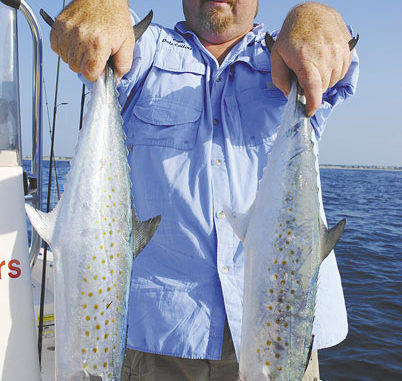
Spanish mackerel love live bait, just not as big as their king mackerel cousins.
The live-bait craze hit the king mackerel world 25 years ago, and in the span of four or five years, every serious fisherman had learned to throw a cast net, every center console had an aerated bait tank, and heavy tackle and trolling spoons had been replaced by light line, rods with fast tips and extra-sharp treble hooks.
It didn’t hurt that an awful lot of fishermen started to catch an awful lot of smoker kings on the relatively light outfits and whatever menhaden, bluefish, croaker or spot happened to be available for bait.
So why did it take so long for fishermen to figure out that if live bait worked on kings, it would work on Spanish mackerel, their smaller, better-tasting cousins?
Fishermen readily told stories about catching big Spanish “accidentally” while live-baiting for kings around nearshore rocks, reefs and livebottoms. How was it that “lightening up” in terms of rods, reels, terminal tackle and bait didn’t sink in, and most fishermen targeting Spanish kept fast-trolling with Clark Spoons and catching plenty of keepers — but few real studs?
Last year, guides Dale Collins and Robbie Hall, who work out of the Swansboro-Emerald Isle area, decided the only spoons they touched would be next to their dinner plates. Using their lighter, everyday trout rods and coming up with a lighter, smaller version of the standard live-bait king rig, they started targeting Spanish mackerel around nearshore rocks and reefs, drifting small baitfish.
It didn’t take them long to figure out they’d hit on something.
“I pulled spoons one time last year,” said Collins, who runs Bait Runner Charters and works at The Reel Outdoors tackle shop in Emerald Isle. “This live-baiting stuff is the deal, and June and July is the time.”
“I didn’t pull a spoon all last summer,” said Hall, of Hall ’Em In Charters. “The live-baiting is so good. Last July, I don’t think I had a trip when we caught less than 20.”
And out of those 20, Collins said, the average fish was a grade larger than the ones hitting trolled spoons. It’s just the nature of live-baiting; it catches bigger kings, and it catches bigger Spanish.
“Robbie had two 9-pound fish (last year), and I’ve had three or four over seven,” said Collins (252-422-4326), who figures things get cracking when the water temperature reaches 68 to 70 degrees. “They’ve averaged between four and six pounds; 5-pound fish are common. In August, September and October, they average three to four pounds, but there will be some bigger ones scattered about.
“If you catch seven or eight Spanish live-baiting one morning, they’ll weigh more than the 15 you catch on a spoon, and the angler gets to participate more; you get to see them bite and get on the rod quicker.”
“It’s a bigger bite,” said Hall (910-330-6999). “The numbers aren’t as big, but you catch bigger fish that will fight harder, and it’s just as easy to do. They’ll show up in the early part of May, and you can catch them all the way through October, with the peak from mid-June to mid-July — that’s the peak of the bigger fish.
“Around Memorial Day, usually you start to pick up the smaller fish, from 10 to 15 inches, but two weeks after that, they get bigger. The water temperature in June is why the fishing is so good and the size of the fish is go good. All you’ve got to be able to do is throw a cast net.”
Well, there is a little more to do than throw a cast net. Finding bait is a big key, but that can be as easy as looking at your nearshore chart and picking out a rock or set of rocks to fish.
Outside Bogue Inlet, within a few miles of the sea buoy, is a series of rocky outcroppings and “low-relief” hardbottom. Jutting from the sandy ocean floor, the rocks attract baitfish the same way that wrecks and artificial reefs do, and where there are baitfish, there are predators like Spanish.
“They’ll be around the rocks that are holding the most bait,” Collins said. “It could be cigar minnows or greenies, little menhaden or big menhaden.”
Within a couple of miles of the inlet are a handful of recognized rocks and low-relief hardbottom, anywhere from a half-mile to several miles off the beach. Station Rock is closest to the inlet but farthest from the beach; just inshore is AR 342, then Keypost No. 2 and No. 1, and closest to the beach but farthest to the northeast is Tom Smith Rock. Most of the structure is in 35 to 55 feet of water.
Keypost No. 1 may be the easiest for the novice fisherman to find; it’s a scant half-mile off the end of Bogue Inlet Pier.
“The Keyposts track to the east; they’re low-relief rocks, and you can pick them up about 700 yards off the pier,” Collins said. “There are two main spots, but you can do the same thing off the artificial reef — anything that holds bait will hold these fish. The same kind of stuff is off Morehead City — the Keyposts are only a 30-minute ride from Beaufort Inlet.”
As the crow flies, the Keyposts are barely a mile-and-a-half from Island Harbor Marina on the sound side of the island, where he keeps his boat. The run to the inlet and up the beach winds up being around 10 miles, but he can stop along the way if conditions point to fish closer to the inlet.
“They’ll stay on the hardbottom out of Bogue Inlet, and the tideline out of the inlet will hold fish as well,” said Collins, who will get over a piece of structure and “power drift” — sometimes using his motor to stay over the rocks. “They fish will stay right over the structure. If you get out of place, you won’t get a strike.”
Collins and Hall said a few outside factors can change the way Spanish will act, including fishing pressure, but they’ve got a few solutions.
“Some days when they aren’t biting, it’s better to just use a single circle hook (in the bait) and no wire,” Hall said. “The ratio of keeping them buttoned up may not be as good, but it’s better than not getting any bites.
“If I’m not catching them one day, I’ll go in on the beach and fish around balls of menhaden. I usually don’t go out in the other direction. You usually don’t catch them as consistently more than five miles off the beach. Most of the fish will be three miles off the beach in 48 to 55 feet of water. The Keyposts are unique in that way.
“The other thing is, a lot of pressure will make them leader shy, and the full-moon phase will make ’em leader shy.”
Collins said that if he can get plenty of bait, chumming will often be the difference in a good catch and a great catch — or a fair catch and a good catch. While he’s particular about the size of the bait he puts on the tiny treble hooks, the menhaden he cracks on the side of the boat’s gunwale and tosses back to attract fish can be any size.
“I like to fish 3- or 4-inch pogies,” he said. “I don’t want anything bigger than five. If they’re not biting and I’ve got plenty of baits, I’ll start tossing baits out there; I think that gets ’em fired up.”

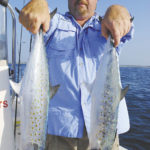
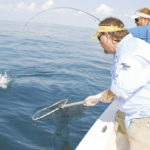
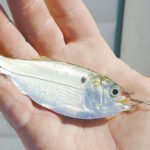
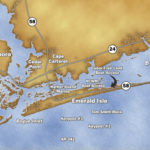

Be the first to comment